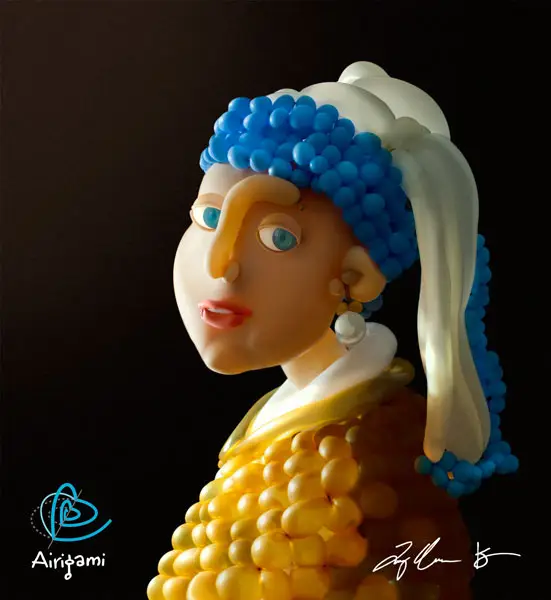It is never more obvious to me that I work in a peculiar medium than when I hear the words, “Wow! It’s just like art!” The implication, of course, is that it’s not ACTUALLY art. It’s only LIKE art. This begs the question, “What is art?” Should the choice of medium have an impact on the definition of a work? Is the permanence of the creation relevant? Does someone have to use the title “artist” in order to create something that we call “art”?
This discussion of what constitutes art has been going on (and will no doubt continue) for centuries. In my opinion, however, any inspired creation should be considered for the title “art”. It can be as intangible as a story told aloud, as temporary as a culinary dish, as “permanent” as a marble sculpture, or as functional as a machine. Most importantly, though, art generates an emotional response from its audience. It would seem, therefore, that almost any creation can then be classified as art. I am not suggesting that every inspired creation is “good” art; just that it was designed intentionally. Likewise, any medium that can be used for creation should be considered a valid medium for art.
It’s not simply the medium that people question. It’s the properties of that medium. People often ask me if I’m bothered that the large sculptures I make are so short-lived. I sometimes wonder if other artists who create transient pieces, such as with ice or sand, get this question as often as I do. I suppose those mediums aren’t temporary in the way that balloons are. Sand castles and ice sculptures, under the right conditions, can be preserved. The basic materials, sand and water, aren’t inherently fragile. Latex balloons, on the other hand, lose air and break down, no matter what I do.
And yet, I’ve never felt that this fleeting nature diminishes the value of my work. In fact, I’d argue it enhances it. The “lifecycle” of a balloon sculpture, if you will, is part of its essence. It’s conceived, designed, assembled, displayed, and ultimately deflated. That cycle isn’t a flaw; it’s a feature. The work isn’t actually complete until it has been viewed and deflated. Its aging and eventual disappearance are integral parts of the piece.
The transience of my sculptures often brings to mind the Tibetan monks who create sand mandalas. These intricate works of art are constructed over several days, only to be intentionally destroyed shortly after completion. The practice serves as a metaphor for impermanence, a reminder that beauty is often fleeting and that its ephemerality is what makes it meaningful. My sculptures share a similar philosophy. They are designed to exist for a moment, to evoke emotion, and to live on—not physically, but in the memories of those who experience them.
Of course, I have explored ways to preserve balloon art. I could apply substances like HiFloat (a commercial product made specifically for balloons) to the inside of the balloons and use protectants similar to those for automobile rubber and vinyl to coat the exterior. These techniques can extend the life of a sculpture, but they’re hardly trivial to apply. The effort and time required to preserve an entire large-scale piece would be monumental.
An alternative approach I’ve pursued over the years is to use balloons as a creative medium for illustration. These flat, two-dimensional pieces transform the ephemeral sculptures into lasting images. A framed print of a balloon creation can hang on a wall forever, but it’s not the same as the original 3D piece. This raises a question I often wrestle with: Does my ability to make my artwork last mean I’m being true to the medium? Or have I completely changed what my medium is? The answer, I’ve come to realize, lies in how I define my art. Is it the physical sculpture I’ve created? Is it the flat print designed to last a lifetime? Or is it something less tangible: the memory of the piece as it exists in the minds of my audience? The more I’ve reflected, the more I’ve come to believe that my art isn’t tied to its physical form. It’s about the emotional response it generates and the memories it leaves behind.
Memories, after all, are fascinating. They don’t just last forever—they evolve. Two people might remember the same sculpture, but their memories won’t be identical. Time and imagination transform those recollections into something larger, more detailed, and more incredible than the original work. In a way, my sculptures become more extraordinary after they’re gone, as their stories are retold and reimagined through the eyes of others.
This is why I find the impermanence of my sculptures so liberating. A physical piece that lasts forever would force the viewer to keep their memory in sync with reality, preventing their imagination from running wild. By contrast, the fleeting nature of balloons invites the audience to take the art with them, to let it grow and change in their minds. That’s what I find most rewarding—hearing people describe my creations years later, often in ways that differ from my own memory of them. Who’s to say whose memory is correct?
I will still use HiFloat when it’s appropriate, like extending the life of a sculpture for a show, and I’ll continue creating photo illustrations so people can enjoy them in books and on their walls. But I’ll never stop embracing the impermanence of my sculptures. To me, art is something that needs to be experienced. It’s not about a lasting, physical entity, but about what the individual viewer takes away from that experience.
No matter the medium, art leaves behind a memory. That memory can last a lifetime, and I find it to be more powerful than any physical piece I could create. That’s why, in my mind, “balloon art is art”, and my art does last forever—or at least as long as the audience does.
